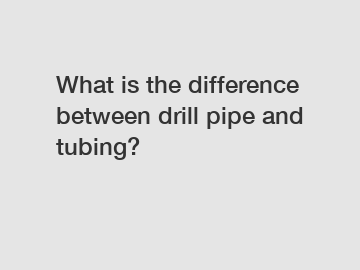Jan. 05, 2024
Minerals & Metallurgy
LONGWAY Product Page
What is the Difference between Drill Pipe and Tubing?
Drilling is a crucial process in the oil and gas industry, and it requires specialized equipment to effectively and efficiently extract oil and gas reserves from the ground. Two important tools used in drilling operations are drill pipes and tubing. While they have similar functions, there are some key differences between the two. In this article, we will explore these differences and shed light on the unique roles each of them plays in drilling operations.

Drill Pipe – The Backbone of Drilling Operations:
Drill pipe is a vital component of any drilling system. It is a hollow, thick-walled steel pipe that connects the surface drilling equipment to the bottom-hole assembly (BHA) and the bit. The primary purpose of the drill pipe is to transmit drilling fluid, torque, and axial force from the drilling rig to the drill bit, allowing for the drilling of various well depths.
Tubing – Facilitating the Production Process:
Tubing, on the other hand, is used in a different stage of the oil and gas production process. It is a smaller diameter pipe that is inserted into a completed oil or gas well to enable the production of hydrocarbons. Tubing plays a critical role in extracting oil and gas from the well and transporting it to the surface for further processing.
H2: Size and Dimensions.
Drill Pipe:
Drill pipe comes in various sizes and dimensions depending on the drilling requirements. It typically ranges from 2 3/8 inches to 6 5/8 inches in outer diameter (OD). The size of the drill pipe is determined by the size of the well and the depth of the drilling operation. The length of drill pipe joints is usually around 31 feet, and they are connected using threaded connections or tool joints.
Tubing:
Tubing, on the other hand, has smaller dimensions compared to drill pipe. It usually ranges from 1.05 inches to 4.5 inches in OD. The size of tubing is determined by the reservoir conditions and the production rates. Tubing is available in various lengths and is connected using threaded connections or integral joints.
H2: Functions and Applications.
Drill Pipe:
Drill pipe is primarily used during the drilling process. It must withstand high axial tension, torque, and bending loads. It also serves as a conduit for drilling mud, which helps cool the drill bit and carries the cuttings back to the surface. Drill pipe is subjected to rigorous wear and tear, so it is made of high-strength alloy steel to ensure durability and longevity.
Tubing:
Tubing, on the other hand, is used for the production of oil and gas. It allows the hydrocarbons to flow from the reservoir to the surface. Tubing is subjected to lower loads compared to drill pipe. It is designed to withstand internal and external pressures, corrosion, and sometimes abrasive elements. Tubing is commonly made of carbon steel or corrosion-resistant alloys to ensure it can withstand the harsh conditions encountered in oil and gas wells.
Closing Paragraph:
In conclusion, while there are similarities between drill pipe and tubing, they serve different functions in oil and gas drilling operations. Drill pipe acts as the backbone of drilling, transmitting forces and drilling fluid to the bit, while tubing facilitates the production process by extracting hydrocarbons from the completed well. Understanding the difference between these two components is crucial for successful drilling and production operations. For more information about drill pipe, tubing, or any other drilling-related questions, please do not hesitate to contact us.
The company is the world’s best geological drill pipe exporter supplier. We are your one-stop shop for all needs. Our staff are highly-specialized and will help you find the product you need.
Previous: Which Nichrome wire 1mm brand offers the best value for money at the purchase stage?
Next: Discover the Benefits of Zincalume Roofs: Long-Lasting Durability, Energy Efficiency, and More!
If you are interested in sending in a Guest Blogger Submission,welcome to write for us!
All Comments ( 0 )